Enhancing Cognitive Performance and Physiological Benefit in Workspaces Through Patterns of Biophilic Design: A Restorative Approach
Abstract
1. Introduction
2. Materials and Methods
2.1. Environmental Setting
2.2. Measures
2.2.1. Subjective Perception
2.2.2. Cognitive Performance
- d-prime (D-P): the participant’s sensitivity in the detection of the target (digit “3”);
- Errors of commission: when a response is made that is incorrect [43], represented here by the times the spacebar is pressed in the presence of the digit “3”;
- Reaction time (RT): the average latency to press the spacebar;
2.2.3. Physiological Response
2.3. Procedure
2.4. Participants
2.5. Statistical Analysis
3. Results
3.1. Perceived Mental Fatigue
3.2. SART Performance
3.3. Cerebral Hemodynamic Changes
3.4. Correlation Between the Indicators
4. Discussion
4.1. Single Biophilic Design Pattern
4.2. Combined Biophilic Design Patterns
4.3. Limitations and Future Work
5. Conclusions
Author Contributions
Funding
Data Availability Statement
Acknowledgments
Conflicts of Interest
Appendix A
| Control | Green Wall | Wood | Combination | |||||
|---|---|---|---|---|---|---|---|---|
| Channel | Before | After | Before | After | Before | After | Before | After |
| 1 | 0.006 | 0.027 | −0.059 | −0.049 | −0.066 | −0.043 | −0.023 | 0.055 |
| 2 | 0.028 | −0.005 | −0.055 | −0.017 | −0.015 | 0.012 | 0.011 | 0.047 |
| 3 | 0.06 | 0.025 | −0.067 | −0.046 | −0.044 | −0.013 | −0.002 | 0.027 |
| 4 | −0.001 | 0.05 | −0.069 | −0.023 | −0.079 | −0.025 | −0.03 | 0.017 |
| 5 | 0.041 | 0.035 | −0.011 | −0.007 | −0.053 | −0.028 | −0.015 | 0.027 |
| 6 | 0.018 | 0.029 | −0.063 | −0.034 | −0.04 | −0.033 | −0.033 | −0.009 |
| 7 | 0.049 | 0.035 | −0.015 | −0.013 | −0.013 | 0.008 | 0.027 | 0.059 |
| 8 | 0.051 | 0.041 | −0.052 | −0.036 | −0.028 | −0.035 | −0.007 | 0.006 |
| 9 | 0.002 | −0.028 | −0.047 | 0.027 | 0.077 | 0.08 | 0.001 | 0.065 |
| 10 | 0.016 | −0.014 | 0.026 | 0.003 | 0.05 | 0.071 | 0.015 | 0.014 |
| 11 | 0.011 | 0.07 | −0.026 | −0.02 | −0.117 | −0.108 | 0.015 | 0.013 |
| 12 | −0.028 | −0.032 | −0.031 | −0.004 | −0.053 | −0.028 | 0.028 | 0.06 |
| 13 | 0.049 | 0.035 | −0.021 | 0.029 | −0.017 | −0.017 | 0.072 | 0.068 |
| 14 | 0.201 | 0.275 | −0.088 | −0.008 | 0.011 | 0.029 | 0.005 | 0.008 |
| 15 | −0.012 | −0.052 | −0.051 | 0.016 | −0.017 | −0.017 | 0.029 | 0.001 |
| 16 | 0.002 | 0.009 | −0.005 | 0.016 | −0.027 | −0.061 | 0.01 | 0.021 |
| 17 | −0.001 | 0.021 | −0.016 | 0.008 | −0.015 | −0.017 | −0.004 | 0.005 |
| 18 | −0.005 | 0.012 | −0.023 | 0.005 | −0.082 | 0.025 | 0.005 | 0.014 |
| 19 | 0 | 0.046 | 0.009 | 0.024 | −0.04 | −0.08 | 0.007 | 0.038 |
| 20 | 0.006 | 0.011 | −0.001 | 0.026 | −0.003 | 0.01 | 0.001 | 0.016 |
| 21 | 0 | 0.026 | −0.024 | −0.018 | −0.017 | 0.013 | 0.033 | 0.042 |
| 22 | −0.007 | 0.046 | −0.037 | 0.028 | −0.008 | 0.015 | −0.003 | 0.024 |
References
- Klepeis, N.E.; Nelson, W.C.; Ott, W.R.; Robinson, J.P.; Tsang, A.M.; Switzer, P.; Behar, J.V.; Hern, S.C.; Engelmann, W.H. The National Human Activity Pattern Survey (NHAPS): A Resource for Assessing Exposure to Environmental Pollutants. J. Expo. Sci. Environ. Epidemiol. 2001, 11, 231–252. [Google Scholar] [CrossRef] [PubMed]
- Awada, M.; Becerik-Gerber, B.; Liu, R.; Seyedrezaei, M.; Lu, Z.; Xenakis, M.; Lucas, G.; Roll, S.C.; Narayanan, S. Ten Questions Concerning the Impact of Environmental Stress on Office Workers. Build. Environ. 2023, 229, 109964. [Google Scholar] [CrossRef]
- Williamson, A.; Friswell, R. Fatigue in the Workplace: Causes and Countermeasures. Fatigue Biomed. Health Behav. 2013, 1, 81–98. [Google Scholar] [CrossRef]
- Lamb, S.; Kwok, K.C.S. A Longitudinal Investigation of Work Environment Stressors on the Performance and Wellbeing of Office Workers. Appl. Ergon. 2016, 52, 104–111. [Google Scholar] [CrossRef]
- United Nation, Department of Economic and Social Affairs. World Urbanization Prospects: The 2018 Revision; United Nations: New York, NY, USA, 2019. [Google Scholar]
- Hartig, T.; Mitchell, R.; de Vries, S.; Frumkin, H. Nature and Health. Annu. Rev. Public Health 2014, 35, 207–228. [Google Scholar] [CrossRef]
- Evans, G.W. The Built Environment and Mental Health. J. Urban Health 2003, 80, 536–555. [Google Scholar] [CrossRef]
- Sullivan, W.C.; Chang, C.-Y. Mental Health and the Built Environment. In Making Healthy Places: Designing and Building for Health, Well-Being, and Sustainability; Dannenberg, A.L., Frumkin, H., Jackson, R.J., Eds.; Island Press/Center for Resource Economics: Washington, DC, USA, 2011; pp. 106–116. ISBN 978-1-61091-036-1. [Google Scholar]
- Kaplan, S. The Restorative Benefits of Nature: Toward an Integrative Framework. J. Environ. Psychol. 1995, 15, 169–182. [Google Scholar] [CrossRef]
- Ulrich, R.S.; Simons, R.F.; Losito, B.D.; Fiorito, E.; Miles, M.A.; Zelson, M. Stress Recovery during Exposure to Natural and Urban Environments. J. Environ. Psychol. 1991, 11, 201–230. [Google Scholar] [CrossRef]
- Kaplan, S.; Berman, M.G. Directed Attention as a Common Resource for Executive Functioning and Self-Regulation. Perspect. Psychol. Sci. 2010, 5, 43–57. [Google Scholar] [CrossRef]
- Markevych, I.; Schoierer, J.; Hartig, T.; Chudnovsky, A.; Hystad, P.; Dzhambov, A.M.; de Vries, S.; Triguero-Mas, M.; Brauer, M.; Nieuwenhuijsen, M.J.; et al. Exploring Pathways Linking Greenspace to Health: Theoretical and Methodological Guidance. Environ. Res. 2017, 158, 301–317. [Google Scholar] [CrossRef]
- Dzhambov, A.M.; Lercher, P.; Browning, M.H.E.M.; Stoyanov, D.; Petrova, N.; Novakov, S.; Dimitrova, D.D. Does Greenery Experienced Indoors and Outdoors Provide an Escape and Support Mental Health during the COVID-19 Quarantine? Environ. Res. 2021, 196, 110420. [Google Scholar] [CrossRef]
- Kellert, S.R.; Heerwagen, J.; Mador, M. Biophilic Design: The Theory, Science and Practice of Bringing Buildings to Life; John Wiley & Sons: Hoboken, NJ, USA, 2011; ISBN 1-118-17424-0. [Google Scholar]
- Wilson, E.O. Biophilia; Harvard University Press: Cambridge, MA, USA, 1986; ISBN 0-674-26839-3. [Google Scholar]
- Yin, J.; Spengler, J. Going Biophilic: Living and Working in Biophilic Buildings. Urban Health 2019, 369–374. [Google Scholar] [CrossRef]
- Ryan, C.O.; Browning, W.D.; Clancy, J.O.; Andrews, S.L.; Kallianpurkar, N.B. Biophilic Design Patterns: Emerging Nature-Based Parameters for Health and Well-Being in the Built Environment. ArchNet-IJAR 2014, 8, 62. [Google Scholar] [CrossRef]
- Ohly, H.; White, M.P.; Wheeler, B.W.; Bethel, A.; Ukoumunne, O.C.; Nikolaou, V.; Garside, R. Attention Restoration Theory: A Systematic Review of the Attention Restoration Potential of Exposure to Natural Environments. J. Toxicol. Environ. Health Part B 2016, 19, 305–343. [Google Scholar] [CrossRef] [PubMed]
- Stevenson, M.P.; Schilhab, T.; Bentsen, P. Attention Restoration Theory II: A Systematic Review to Clarify Attention Processes Affected by Exposure to Natural Environments. J. Toxicol. Environ. Health Part B 2018, 21, 227–268. [Google Scholar] [CrossRef]
- Corazon, S.S.; Sidenius, U.; Poulsen, D.V.; Gramkow, M.C.; Stigsdotter, U.K. Psycho-Physiological Stress Recovery in Outdoor Nature-Based Interventions: A Systematic Review of the Past Eight Years of Research. Int. J. Environ. Res. Public Health 2019, 16, 1711. [Google Scholar] [CrossRef] [PubMed]
- Yin, J.; Yuan, J.; Arfaei, N.; Catalano, P.J.; Allen, J.G.; Spengler, J.D. Effects of Biophilic Indoor Environment on Stress and Anxiety Recovery: A between-Subjects Experiment in Virtual Reality. Environ. Int. 2020, 136, 105427. [Google Scholar] [CrossRef]
- Li, D.; Sullivan, W.C. Impact of Views to School Landscapes on Recovery from Stress and Mental Fatigue. Landsc. Urban Plan. 2016, 148, 149–158. [Google Scholar] [CrossRef]
- Higuera-Trujillo, J.L.; Llinares Millán, C.; Montañana i Aviñó, A.; Rojas, J.-C. Multisensory Stress Reduction: A Neuro-Architecture Study of Paediatric Waiting Rooms. Build. Res. Inf. 2020, 48, 269–285. [Google Scholar] [CrossRef]
- Liu, G.; Zou, J.; Qiao, M.; Zhu, H.; Yang, Y.; Guan, H.; Hu, S. Stress Recovery at Home: Effects of the Indoor Visual and Auditory Stimuli in Buildings. Build. Environ. 2023, 244, 110752. [Google Scholar] [CrossRef]
- Dematte, M.L.; Zanetti, M.; Urso, T.; Cavalli, R. Wooden Indoor Environments’ Restorativeness. Forests 2022, 13, 2073. [Google Scholar] [CrossRef]
- Li, Z.; Huang, X.; White, M. Effects of the Visual Character of Transitional Spaces on Human Stress Recovery in a Virtual Reality Environment. Int. J. Environ. Res. Public Health 2022, 19, 13143. [Google Scholar] [CrossRef] [PubMed]
- Gao, C.; Zhang, S. The Restorative Quality of Patient Ward Environment: Tests of Six Dominant Design Characteristics. Build. Environ. 2020, 180, 107039. [Google Scholar] [CrossRef]
- Lyu, K.; de Dear, R.; Brambilla, A.; Globa, A. Restorative Benefits of Semi-Outdoor Environments at the Workplace: Does the Thermal Realm Matter? Build. Environ. 2022, 222, 109355. [Google Scholar] [CrossRef]
- Li, Z.; Wang, Y.; Liu, H.; Liu, H. Physiological and Psychological Effects of Exposure to Different Types and Numbers of Biophilic Vegetable Walls in Small Spaces. Build. Environ. 2022, 225, 109645. [Google Scholar] [CrossRef]
- Fang, Z.; Xu, H.; Tao, L.; Tan, Y.; Li, Y.; Wu, J. Effects of Volume Ratio, Layout and Leave Size of Indoor Plants on Workers’ Attention Recovery in Factory Staff Break Area. Buildings 2023, 13, 622. [Google Scholar] [CrossRef]
- Abd-Alhamid, F.; Kent, M.; Calautit, J.; Wu, Y. Evaluating the Impact of Viewing Location on View Perception Using a Virtual Environment. Build. Environ. 2020, 180, 106932. [Google Scholar] [CrossRef]
- Wilson, C.J.; Soranzo, A. The Use of Virtual Reality in Psychology: A Case Study in Visual Perception. Comput. Math. Methods Med. 2015, 2015, e151702. [Google Scholar] [CrossRef]
- Emamjomeh, A.; Zhu, Y.; Beck, M. The Potential of Applying Immersive Virtual Environment to Biophilic Building Design: A Pilot Study. J. Build. Eng. 2020, 32, 101481. [Google Scholar] [CrossRef]
- Chang, E.; Kim, H.T.; Yoo, B. Virtual Reality Sickness: A Review of Causes and Measurements. Int. J. Hum. Comput. Interact. 2020, 36, 1658–1682. [Google Scholar] [CrossRef]
- Bratman, G.N.; Hamilton, J.P.; Daily, G.C. The Impacts of Nature Experience on Human Cognitive Function and Mental Health: Nature Experience, Cognitive Function, and Mental Health. Ann. N. Y. Acad. Sci. 2012, 1249, 118–136. [Google Scholar] [CrossRef] [PubMed]
- Yeom, S.; Kim, H.; Hong, T. Psychological and Physiological Effects of a Green Wall on Occupants: A Cross-over Study in Virtual Reality. Build. Environ. 2021, 204, 108134. [Google Scholar] [CrossRef]
- Tsunetsugu, Y.; Miyazaki, Y.; Sato, H. Physiological Effects in Humans Induced by the Visual Stimulation of Room Interiors with Different Wood Quantities. J. Wood Sci. 2007, 53, 11–16. [Google Scholar] [CrossRef]
- Streiner, D.L.; Norman, G.R.; Cairney, J. Health Measurement Scales: A Practical Guide to Their Development and Use; Oxford University Press: New York, NY, USA, 2015; ISBN 0-19-968521-5. [Google Scholar]
- Lesage, F.-X.; Berjot, S.; Deschamps, F. Clinical Stress Assessment Using a Visual Analogue Scale. Occup. Med. 2012, 62, 600–605. [Google Scholar] [CrossRef]
- Robertson, I.H.; Manly, T.; Andrade, J.; Baddeley, B.T.; Yiend, J. ‘Oops!’: Performance Correlates of Everyday Attentional Failures in Traumatic Brain Injured and Normal Subjects. Neuropsychologia 1997, 35, 747–758. [Google Scholar] [CrossRef]
- Berto, R. Exposure to Restorative Environments Helps Restore Attentional Capacity. J. Environ. Psychol. 2005, 25, 249–259. [Google Scholar] [CrossRef]
- Peirce, J.; Gray, J.R.; Simpson, S.; MacAskill, M.; Höchenberger, R.; Sogo, H.; Kastman, E.; Lindeløv, J.K. PsychoPy2: Experiments in Behavior Made Easy. Behav. Res. 2019, 51, 195–203. [Google Scholar] [CrossRef] [PubMed]
- Noorani, I.; Carpenter, R.H. The LATER Model of Reaction Time and Decision. Neurosci. Biobehav. Rev. 2016, 64, 229–251. [Google Scholar] [CrossRef]
- Bruyer, R.; Brysbaert, M. Combining Speed and Accuracy in Cognitive Psychology: Is the Inverse Efficiency Score (IES) a Better Dependent Variable than the Mean Reaction Time (RT) and the Percentage of Errors (PE)? Psychol. Belg. 2011, 51, 5–13. [Google Scholar] [CrossRef]
- Cassarino, M.; Maisto, M.; Esposito, Y.; Guerrero, D.; Chan, J.S.; Setti, A. Testing Attention Restoration in a Virtual Reality Driving Simulator. Front. Psychol. 2019, 10, 250. [Google Scholar] [CrossRef]
- Mehta, R.; Parasuraman, R. Neuroergonomics: A Review of Applications to Physical and Cognitive Work. Front. Hum. Neurosci. 2013, 7, 889. [Google Scholar] [CrossRef] [PubMed]
- Pinti, P.; Tachtsidis, I.; Hamilton, A.; Hirsch, J.; Aichelburg, C.; Gilbert, S.; Burgess, P.W. The Present and Future Use of Functional Near-infrared Spectroscopy (fNIRS) for Cognitive Neuroscience. Ann. N. Y. Acad. Sci. 2020, 1464, 5–29. [Google Scholar] [CrossRef] [PubMed]
- Perrey, S. Non-Invasive NIR Spectroscopy of Human Brain Function during Exercise. Methods 2008, 45, 289–299. [Google Scholar] [CrossRef]
- Miller, E.K.; Cohen, J.D. An Integrative Theory of Prefrontal Cortex Function. Annu. Rev. Neurosci. 2001, 24, 167–202. [Google Scholar] [CrossRef] [PubMed]
- Li, T.; Lin, Y.; Gao, Y.; Zhong, F. Longtime Driving Induced Cerebral Hemodynamic Elevation and Behavior Degradation as Assessed by Functional Near-infrared Spectroscopy and a Voluntary Attention Test. J. Biophotonics 2018, 11, e201800160. [Google Scholar] [CrossRef]
- Li, Z.; Zhang, M.; Zhang, X.; Dai, S.; Yu, X.; Wang, Y. Assessment of Cerebral Oxygenation during Prolonged Simulated Driving Using near Infrared Spectroscopy: Its Implications for Fatigue Development. Eur. J. Appl. Physiol. 2009, 107, 281–287. [Google Scholar] [CrossRef]
- Xu, L.; Wang, B.; Xu, G.; Wang, W.; Liu, Z.; Li, Z. Functional Connectivity Analysis Using fNIRS in Healthy Subjects during Prolonged Simulated Driving. Neurosci. Lett. 2017, 640, 21–28. [Google Scholar] [CrossRef]
- Imamura, C.; Sakakibara, K.; Arai, K.; Ohira, H.; Yamaguchi, Y.; Yamada, H. Effect of Indoor Forest Bathing on Reducing Feelings of Fatigue Using Cerebral Activity as an Indicator. Int. J. Environ. Res. Public Health 2022, 19, 6672. [Google Scholar] [CrossRef]
- Zhang, Z.; Yang, H.; Cao, Y.; Xu, F.; Jiang, J.; Jiao, X. The Effect of Mental Fatigue on Sustained Attention: An fNIRS Study. In Proceedings of the International Conference on Innovative Optical Health Science, Shanghai, China, 5 January 2017; Li, X., Luo, Q., Eds.; SPIE: Bellingham, WA, USA; p. 102450G. [Google Scholar]
- Tanaka, M.; Shigihara, Y.; Ishii, A.; Funakura, M.; Kanai, E.; Watanabe, Y. Effect of Mental Fatigue on the Central Nervous System: An Electroencephalography Study. Behav. Brain Funct. 2012, 8, 48. [Google Scholar] [CrossRef]
- Barton, J.; Pretty, J. What Is the Best Dose of Nature and Green Exercise for Improving Mental Health? A Multi-Study Analysis. Environ. Sci. Technol. 2010, 44, 3947–3955. [Google Scholar] [CrossRef]
- Rhee, J.H.; Schermer, B.; Han, G.; Park, S.Y.; Lee, K.H. Effects of Nature on Restorative and Cognitive Benefits in Indoor Environment. Sci. Rep. 2023, 13, 13199. [Google Scholar] [CrossRef] [PubMed]
- Ko, W.H.; Schiavon, S.; Zhang, H.; Graham, L.T.; Brager, G.; Mauss, I.; Lin, Y.-W. The Impact of a View from a Window on Thermal Comfort, Emotion, and Cognitive Performance. Build. Environ. 2020, 175, 106779. [Google Scholar] [CrossRef]
- Lan, L.; Lian, Z. Application of Statistical Power Analysis—How to Determine the Right Sample Size in Human Health, Comfort and Productivity Research. Build. Environ. 2010, 45, 1202–1213. [Google Scholar] [CrossRef]
- Shigihara, Y.; Tanaka, M.; Ishii, A.; Kanai, E.; Funakura, M.; Watanabe, Y. Two Types of Mental Fatigue Affect Spontaneous Oscillatory Brain Activities in Different Ways. Behav. Brain Funct. 2013, 9, 2. [Google Scholar] [CrossRef]
- Raanaas, R.K.; Evensen, K.H.; Rich, D.; Sjøstrøm, G.; Patil, G. Benefits of Indoor Plants on Attention Capacity in an Office Setting. J. Environ. Psychol. 2011, 31, 99–105. [Google Scholar] [CrossRef]
- van den Bogerd, N.; Dijkstra, S.C.; Koole, S.L.; Seidell, J.C.; Maas, J. Greening the Room: A Quasi-Experimental Study on the Presence of Potted Plants in Study Rooms on Mood, Cognitive Performance, and Perceived Environmental Quality among University Students. J. Environ. Psychol. 2021, 73, 101557. [Google Scholar] [CrossRef]
- Lipovac, D.; Zitnik, J.; Burnard, M.D. A Pilot Study Examining the Suitability of the Mental Arithmetic Task and Single-Item Measures of Affective States to Assess Affective, Physiological, and Attention Restoration at a Wooden Desk. J. Wood Sci. 2022, 68, 35. [Google Scholar] [CrossRef]
- Burnard, M.D.; Kutnar, A. Human Stress Responses in Office-like Environments with Wood Furniture. Build. Res. Inf. 2020, 48, 316–330. [Google Scholar] [CrossRef]
- Cassarino, M.; Tuohy, I.C.; Setti, A. Sometimes Nature Doesn’t Work: Absence of Attention Restoration in Older Adults Exposed to Environmental Scenes. Exp. Aging Res. 2019, 45, 372–385. [Google Scholar] [CrossRef]
- Neilson, B.N.; Craig, C.M.; Curiel, R.Y.; Klein, M.I. Restoring Attentional Resources With Nature: A Replication Study of Berto’s (2005) Paradigm Including Commentary From Dr. Rita Berto. Hum. Factors 2021, 63, 1046–1060. [Google Scholar] [CrossRef]
- Li, Z.; Zhang, W.; Cui, J.; Wang, L.; Liu, H.; Liu, H. Biophilic Environment with Visual-Olfactory Stimuli Contributes to Psychophysiological Restoration and Cognitive Enhancement. Build. Environ. 2024, 250, 111202. [Google Scholar] [CrossRef]
- Lin, W.; Zeng, C.; Bao, Z.; Jin, H. The Therapeutic Look up: Stress Reduction and Attention Restoration Vary According to the Sky-Leaf-Trunk (SLT) Ratio in Canopy Landscapes. Landsc. Urban Plan. 2023, 234, 104730. [Google Scholar] [CrossRef]
- Chen, Z.; He, Y.; Yu, Y. Attention Restoration during Environmental Exposure via Alpha-Theta Oscillations and Synchronization. J. Environ. Psychol. 2020, 68, 101406. [Google Scholar] [CrossRef]
- Pals, R.; Steg, L.; Dontje, J.; Siero, F.W.; Van Der Zee, K.I. Physical Features, Coherence and Positive Outcomes of Person–Environment Interactions: A Virtual Reality Study. J. Environ. Psychol. 2014, 40, 108–116. [Google Scholar] [CrossRef]
- Joye, Y.; van den Berg, A. Is Love for Green in Our Genes? A Critical Analysis of Evolutionary Assumptions in Restorative Environments Research. Urban For. Urban Green. 2011, 10, 261–268. [Google Scholar] [CrossRef]
- Joye, Y. Architectural Lessons from Environmental Psychology: The Case of Biophilic Architecture. Rev. Gen. Psychol. 2007, 11, 305–328. [Google Scholar] [CrossRef]
- Alexander, C. The Nature of Order: The Phenomenon of Life; Center for Environmental Structure: Inverness, CA, USA, 2002; ISBN 0-9726529-1-4. [Google Scholar]
- Taylor, R. The Potential of Biophilic Fractal Designs to Promote Health and Performance: A Review of Experiments and Applications. Sustainability 2021, 13, 823. [Google Scholar] [CrossRef]
- Purcell, T.; Peron, E.; Berto, R. Why Do Preferences Differ between Scene Types? Environ. Behav. 2001, 33, 93–106. [Google Scholar] [CrossRef]
- You, J.; Wen, X.; Liu, L.; Yin, J.; Ji, J.S. Biophilic Classroom Environments on Stress and Cognitive Performance: A Randomized Crossover Study in Virtual Reality (VR). PLoS ONE 2023, 18, e0291355. [Google Scholar] [CrossRef]
- Jiang, B.; Chang, C.-Y.; Sullivan, W.C. A Dose of Nature: Tree Cover, Stress Reduction, and Gender Differences. Landsc. Urban Plan. 2014, 132, 26–36. [Google Scholar] [CrossRef]
- Rhee, J.H.; Schermer, B.; Cha, S.H. Effects of Indoor Vegetation Density on Human Well-Being for a Healthy Built Environment. Dev. Built Environ. 2023, 14, 100172. [Google Scholar] [CrossRef]

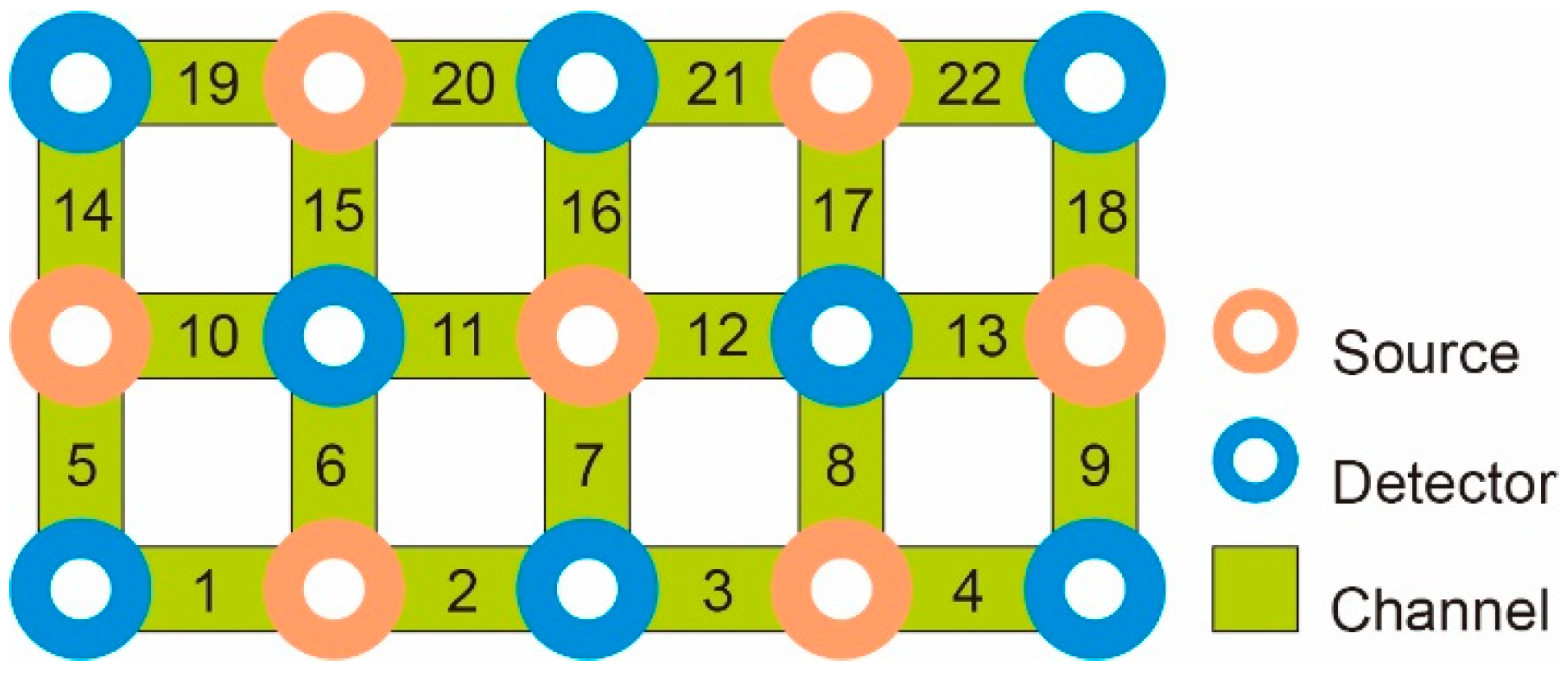
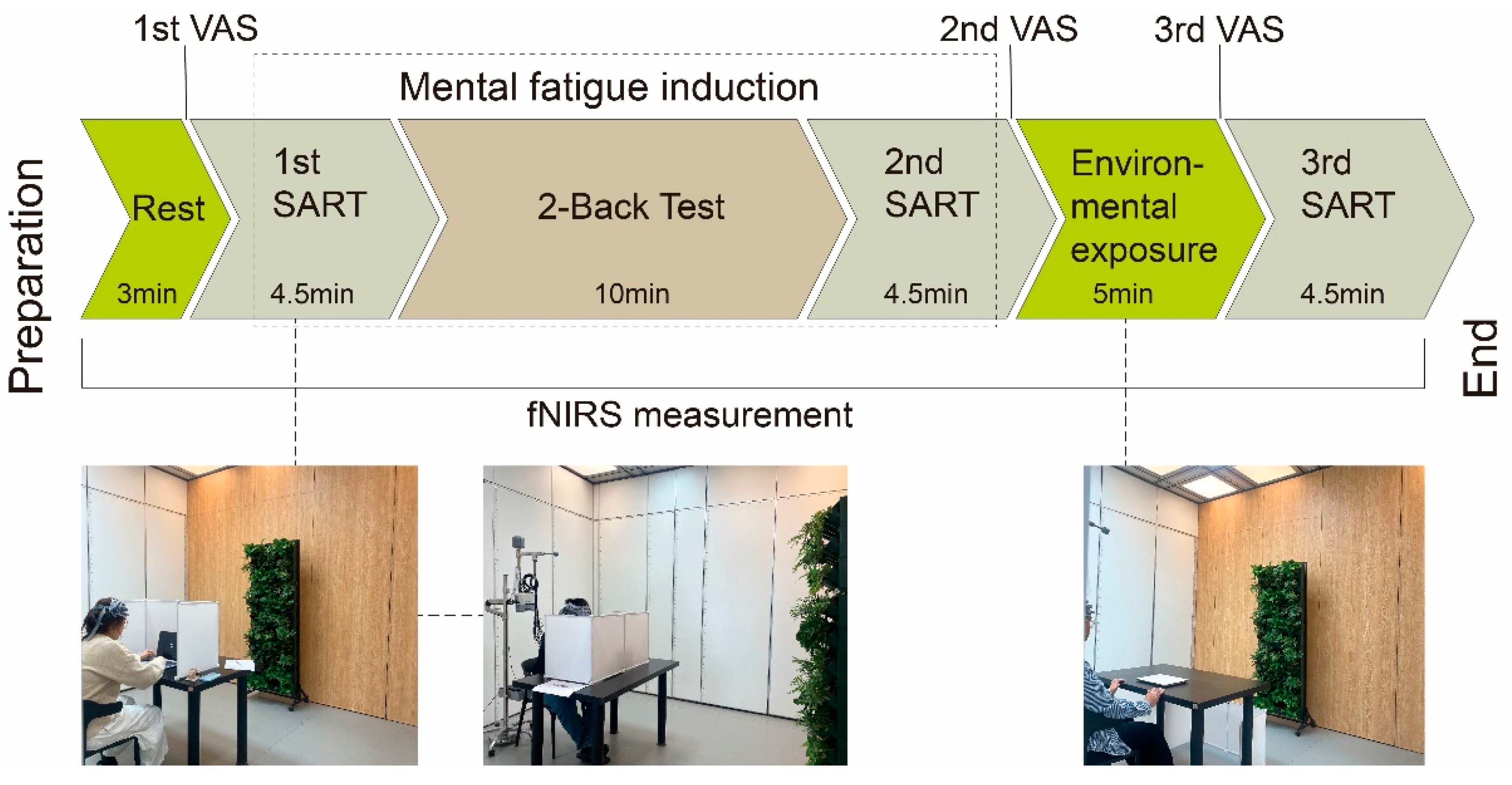
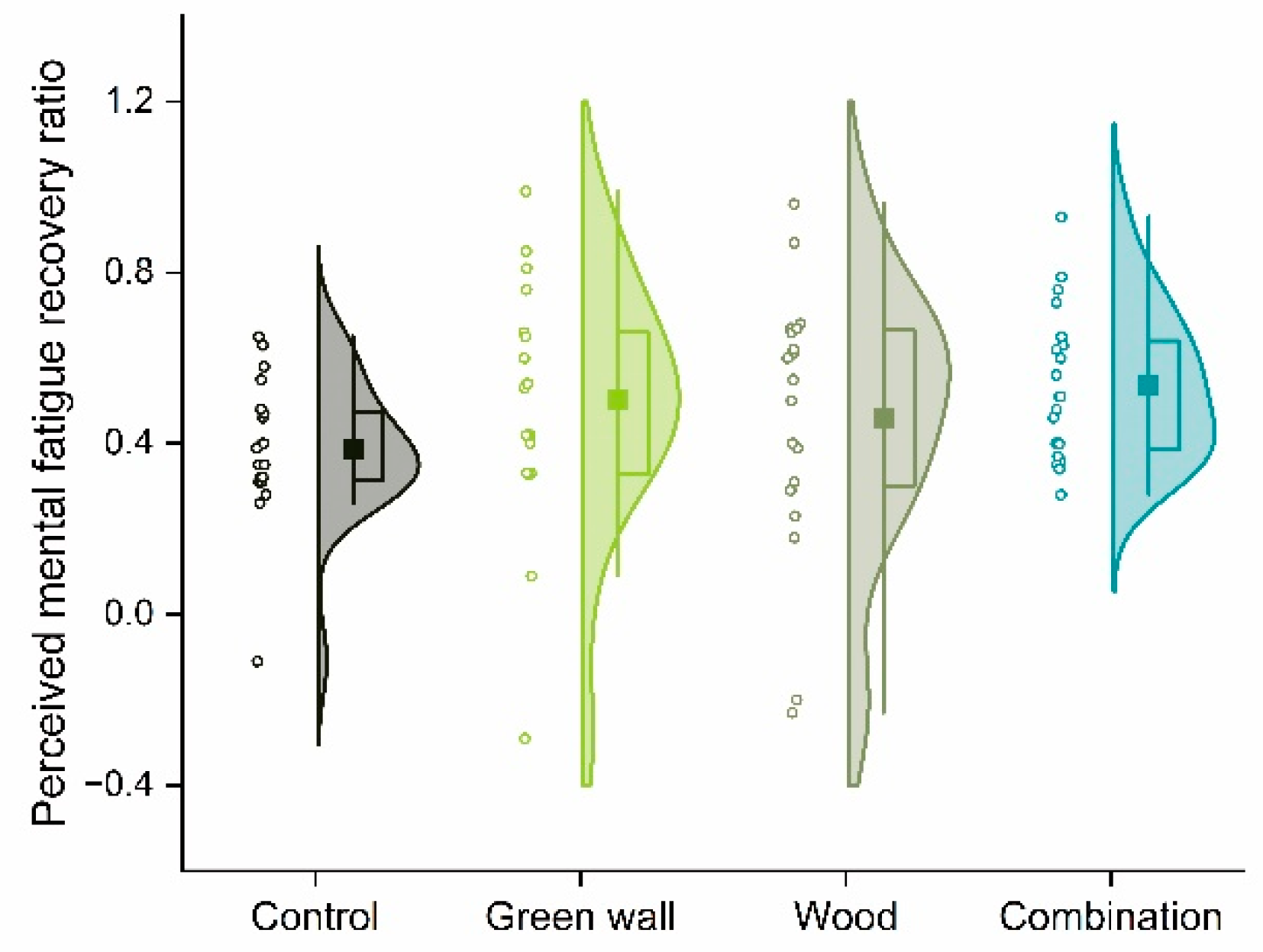

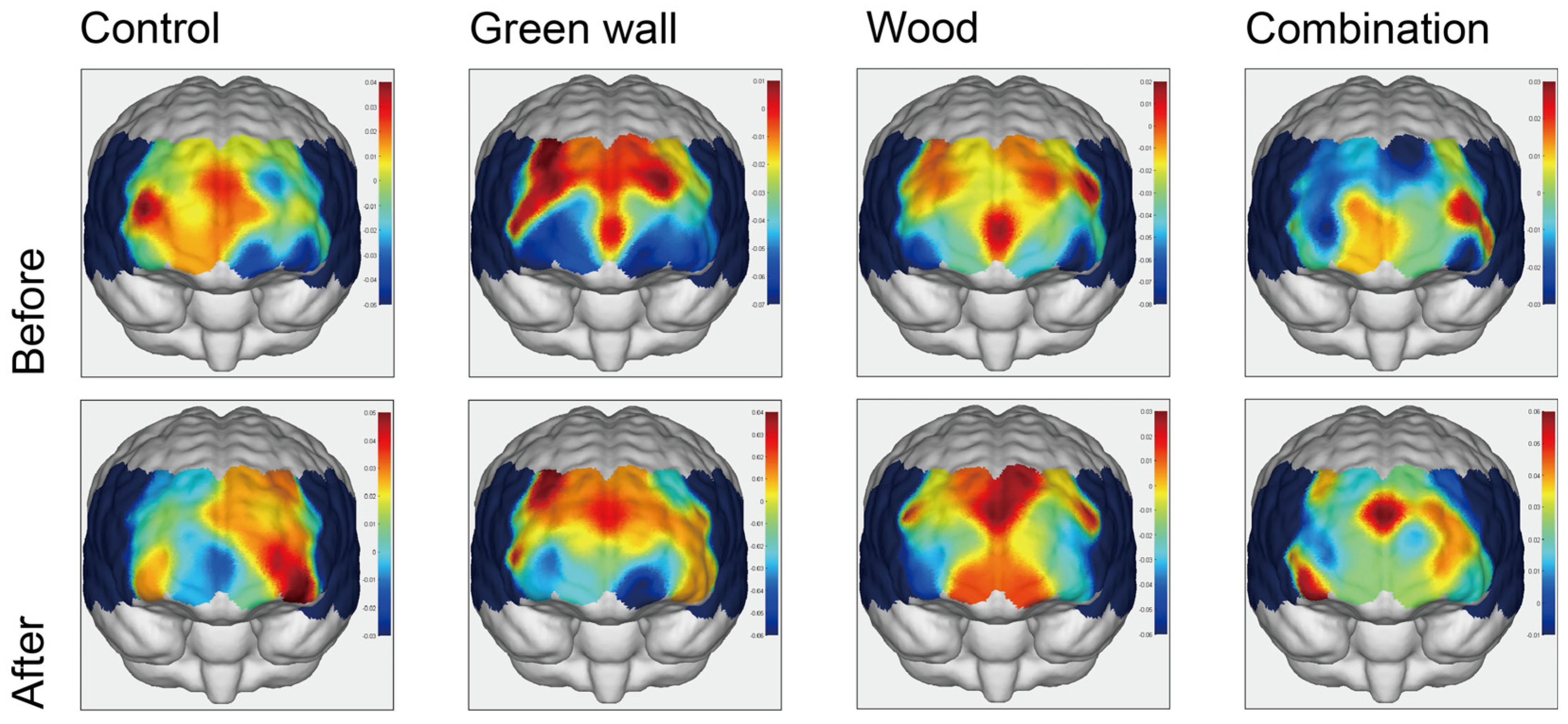
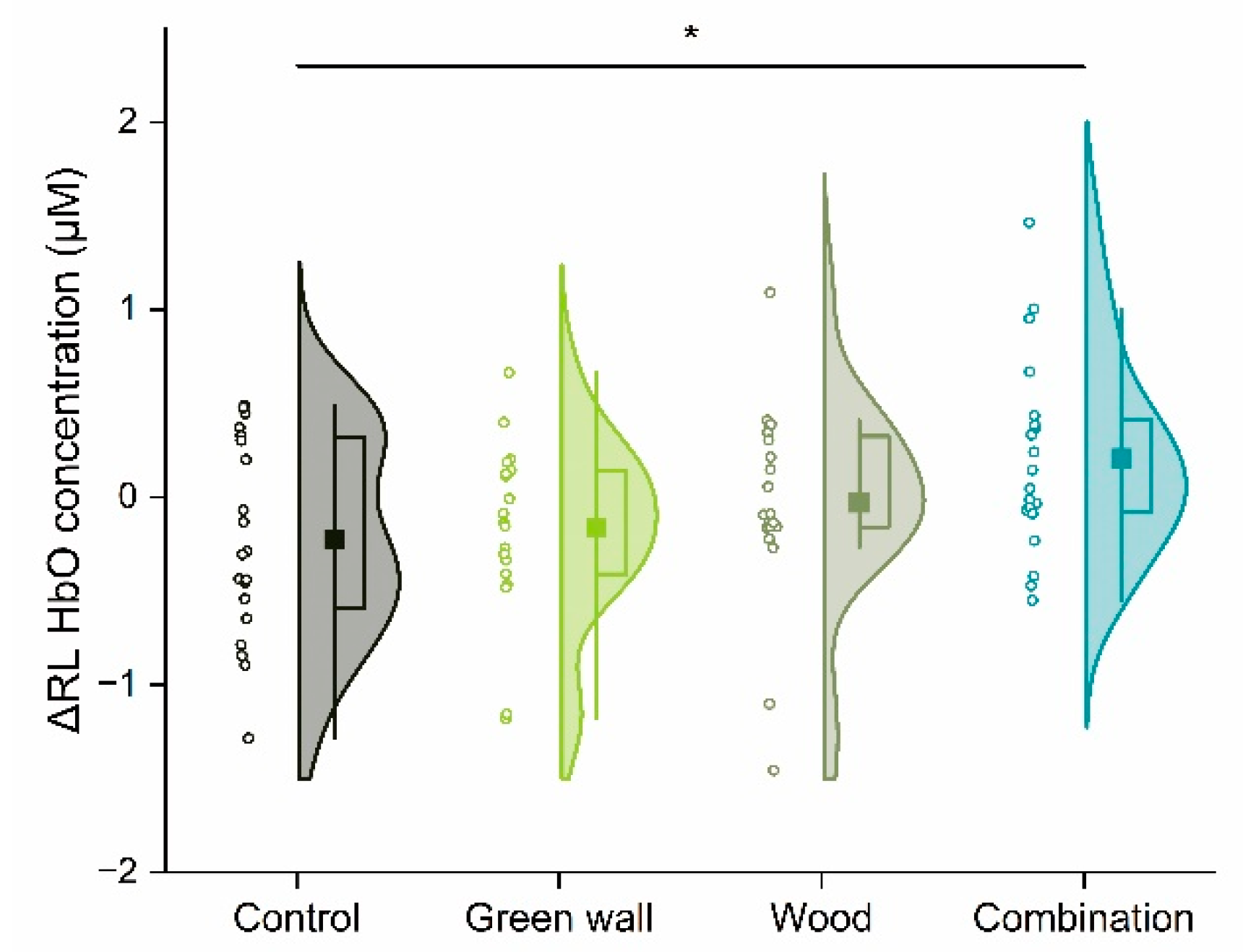
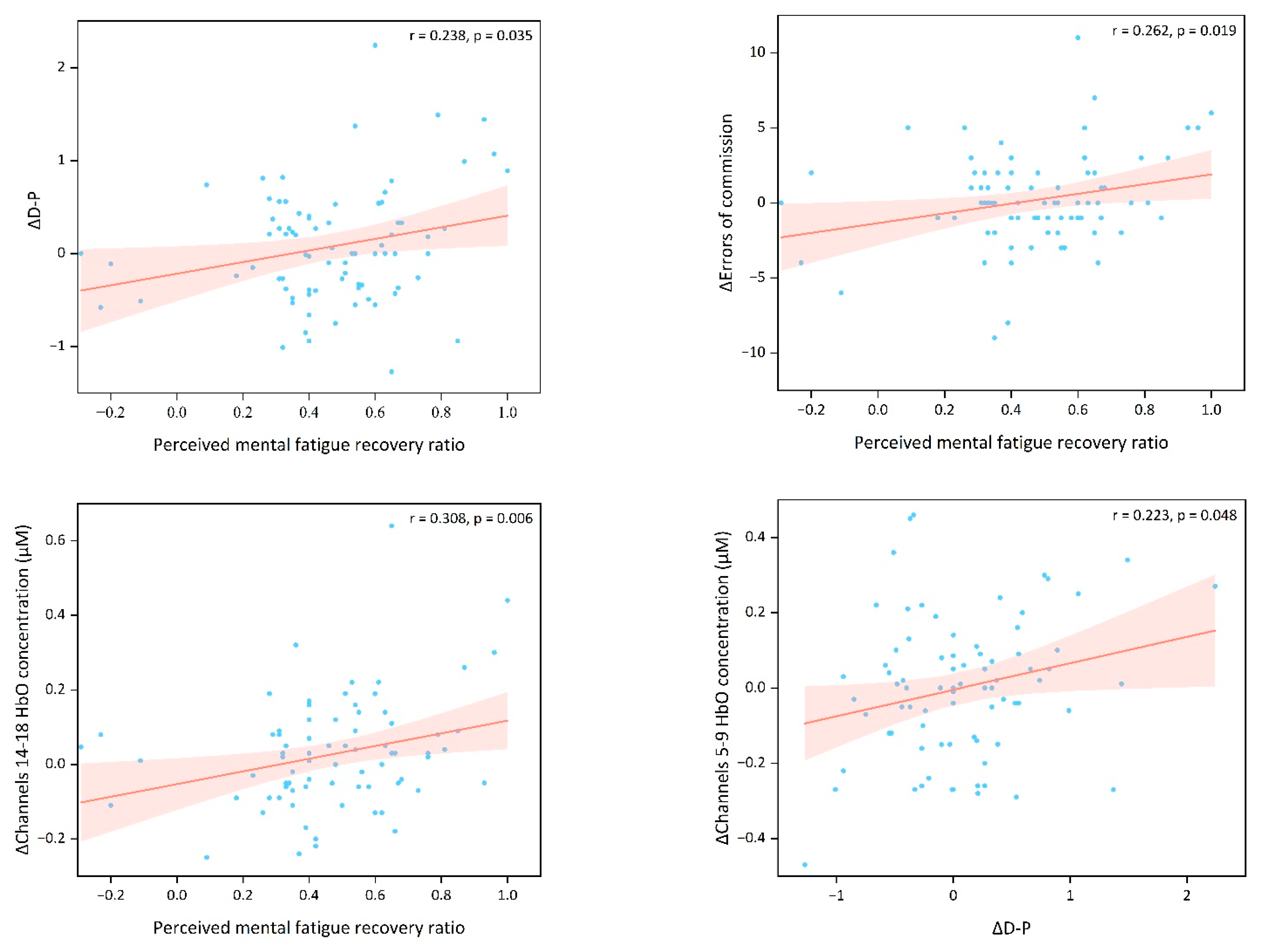
| Categories | Patterns | ||
|---|---|---|---|
| Nature in the Space | Visual Connection with Nature | Non-Visual Connection with Nature | Non-Rhythmic Sensory Stimuli |
| Thermal and Airflow Variability | Presence of Water | Dynamic and Diffuse Light | |
| Connection with Natural Systems | |||
| Natural Analogs | Biomorphic Forms and Patterns | Material Connection with Nature | Complexity and Order |
| Nature of the Space | Prospect | Refuge | Mystery |
| Risk/Peril |
| Group | Before Induction | After Induction | p-Value | Effect Size (Cohen’s d) |
|---|---|---|---|---|
| Control | 19.3 (20.1) | 61.5 (15.7) | <0.001 | 1.995 |
| Green Wall | 22.8 (23.1) | 54.9 (23.0) | <0.001 | 1.346 |
| Wood | 12.0 (13.6) | 50.7 (23.8) | <0.001 | 1.766 |
| Combination | 22.6 (14.7) | 61.9 (19.7) | <0.001 | 1.993 |
| Group | ΔD-P | ΔErrors of Commission | ΔRT | ΔIES |
|---|---|---|---|---|
| Control | −0.16 (0.58) | −1.35 (3.50) | 28.12 (50.86) | 30.74 (52.09) |
| Green Wall | 0.03 (0.63) | 0.16 (2.24) | 3.43 (44.65) | 4.02 (47.46) |
| Wood | 0.15 (0.47) | 0.55 (2.28) | 5.22 (22.40) | 3.81 (25.28) |
| Combination | 0.31 (0.67) | 1.40 (3.49) | −1.22 (51.14) | 2.65 (51.30) |
Disclaimer/Publisher’s Note: The statements, opinions and data contained in all publications are solely those of the individual author(s) and contributor(s) and not of MDPI and/or the editor(s). MDPI and/or the editor(s) disclaim responsibility for any injury to people or property resulting from any ideas, methods, instructions or products referred to in the content. |
© 2024 by the authors. Licensee MDPI, Basel, Switzerland. This article is an open access article distributed under the terms and conditions of the Creative Commons Attribution (CC BY) license (https://creativecommons.org/licenses/by/4.0/).
Share and Cite
Zhang, P.; Yu, Z.; Hou, G.; Shu, P.; Bo, Y.; Shi, Y.; Nie, R. Enhancing Cognitive Performance and Physiological Benefit in Workspaces Through Patterns of Biophilic Design: A Restorative Approach. Buildings 2024, 14, 3293. https://doi.org/10.3390/buildings14103293
Zhang P, Yu Z, Hou G, Shu P, Bo Y, Shi Y, Nie R. Enhancing Cognitive Performance and Physiological Benefit in Workspaces Through Patterns of Biophilic Design: A Restorative Approach. Buildings. 2024; 14(10):3293. https://doi.org/10.3390/buildings14103293
Chicago/Turabian StyleZhang, Ping, Zhengqi Yu, Guoying Hou, Ping Shu, Yunque Bo, Yankun Shi, and Rui Nie. 2024. "Enhancing Cognitive Performance and Physiological Benefit in Workspaces Through Patterns of Biophilic Design: A Restorative Approach" Buildings 14, no. 10: 3293. https://doi.org/10.3390/buildings14103293
APA StyleZhang, P., Yu, Z., Hou, G., Shu, P., Bo, Y., Shi, Y., & Nie, R. (2024). Enhancing Cognitive Performance and Physiological Benefit in Workspaces Through Patterns of Biophilic Design: A Restorative Approach. Buildings, 14(10), 3293. https://doi.org/10.3390/buildings14103293





